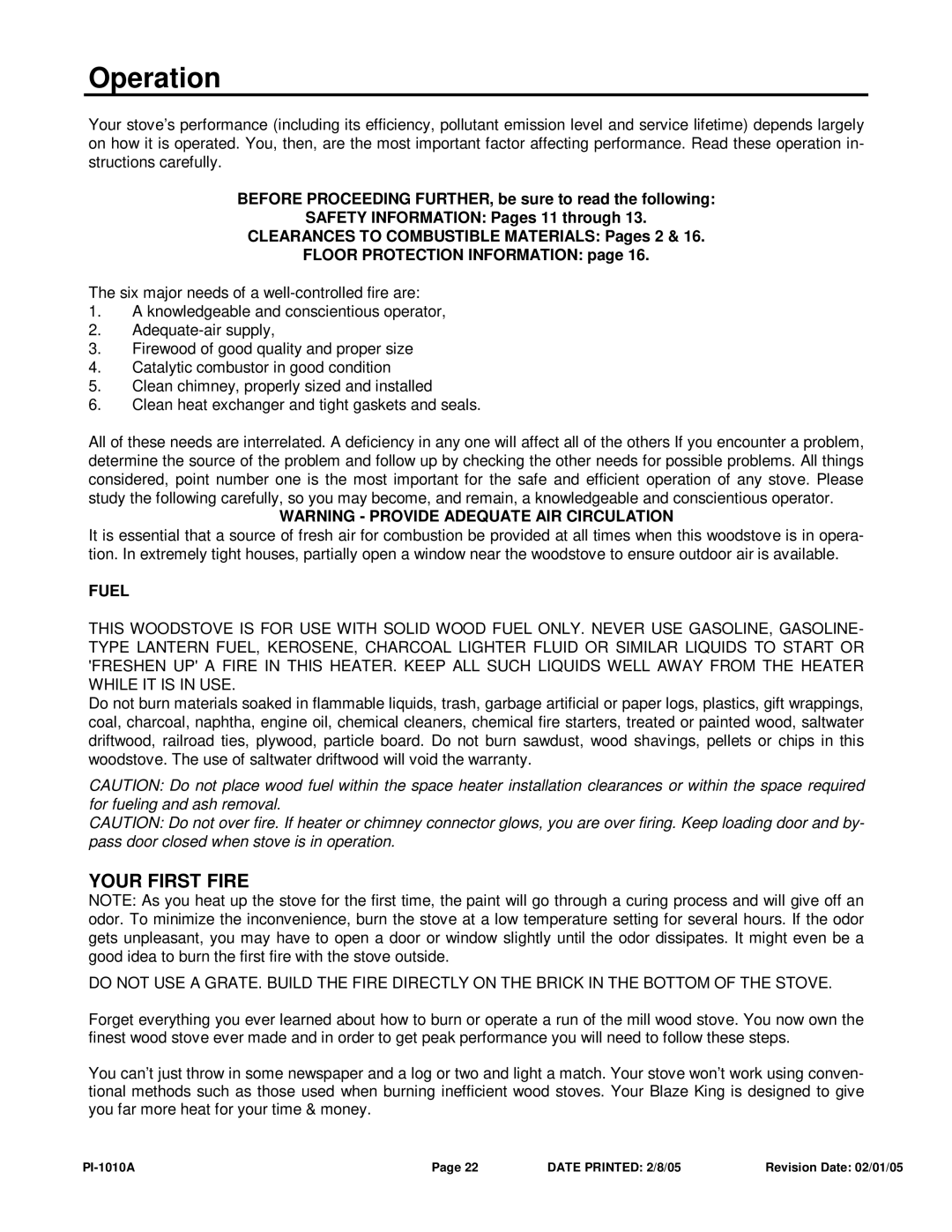Operation
Your stove’s performance (including its efficiency, pollutant emission level and service lifetime) depends largely on how it is operated. You, then, are the most important factor affecting performance. Read these operation in- structions carefully.
BEFORE PROCEEDING FURTHER, be sure to read the following:
SAFETY INFORMATION: Pages 11 through 13.
CLEARANCES TO COMBUSTIBLE MATERIALS: Pages 2 & 16.
FLOOR PROTECTION INFORMATION: page 16.
The six major needs of a
1.A knowledgeable and conscientious operator,
2.
3.Firewood of good quality and proper size
4.Catalytic combustor in good condition
5.Clean chimney, properly sized and installed
6.Clean heat exchanger and tight gaskets and seals.
All of these needs are interrelated. A deficiency in any one will affect all of the others If you encounter a problem, determine the source of the problem and follow up by checking the other needs for possible problems. All things considered, point number one is the most important for the safe and efficient operation of any stove. Please study the following carefully, so you may become, and remain, a knowledgeable and conscientious operator.
WARNING - PROVIDE ADEQUATE AIR CIRCULATION
It is essential that a source of fresh air for combustion be provided at all times when this woodstove is in opera- tion. In extremely tight houses, partially open a window near the woodstove to ensure outdoor air is available.
FUEL
THIS WOODSTOVE IS FOR USE WITH SOLID WOOD FUEL ONLY. NEVER USE GASOLINE, GASOLINE- TYPE LANTERN FUEL, KEROSENE, CHARCOAL LIGHTER FLUID OR SIMILAR LIQUIDS TO START OR 'FRESHEN UP' A FIRE IN THIS HEATER. KEEP ALL SUCH LIQUIDS WELL AWAY FROM THE HEATER WHILE IT IS IN USE.
Do not burn materials soaked in flammable liquids, trash, garbage artificial or paper logs, plastics, gift wrappings, coal, charcoal, naphtha, engine oil, chemical cleaners, chemical fire starters, treated or painted wood, saltwater driftwood, railroad ties, plywood, particle board. Do not burn sawdust, wood shavings, pellets or chips in this woodstove. The use of saltwater driftwood will void the warranty.
CAUTION: Do not place wood fuel within the space heater installation clearances or within the space required for fueling and ash removal.
CAUTION: Do not over fire. If heater or chimney connector glows, you are over firing. Keep loading door and by- pass door closed when stove is in operation.
YOUR FIRST FIRE
NOTE: As you heat up the stove for the first time, the paint will go through a curing process and will give off an odor. To minimize the inconvenience, burn the stove at a low temperature setting for several hours. If the odor gets unpleasant, you may have to open a door or window slightly until the odor dissipates. It might even be a good idea to burn the first fire with the stove outside.
DO NOT USE A GRATE. BUILD THE FIRE DIRECTLY ON THE BRICK IN THE BOTTOM OF THE STOVE.
Forget everything you ever learned about how to burn or operate a run of the mill wood stove. You now own the finest wood stove ever made and in order to get peak performance you will need to follow these steps.
You can’t just throw in some newspaper and a log or two and light a match. Your stove won’t work using conven- tional methods such as those used when burning inefficient wood stoves. Your Blaze King is designed to give you far more heat for your time & money.
Page 22 | DATE PRINTED: 2/8/05 | Revision Date: 02/01/05 |
